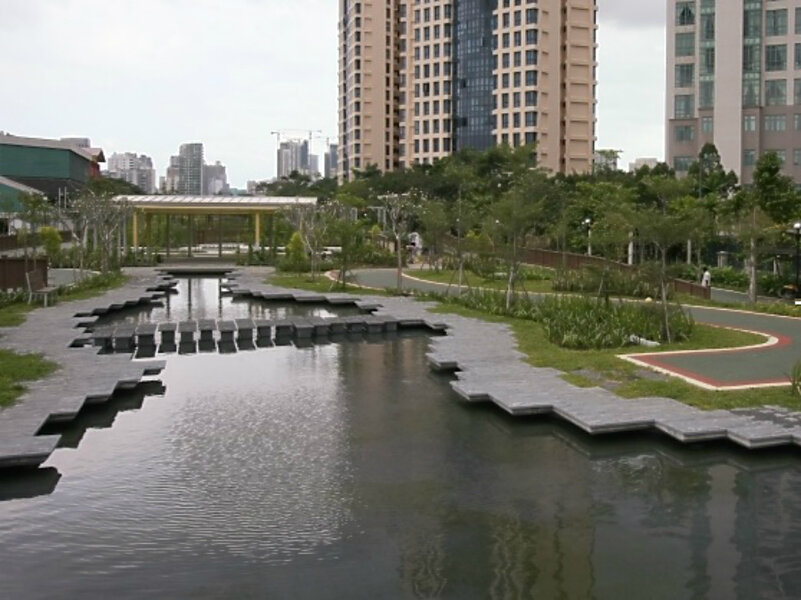Water-short Singapore charts a course toward self-sufficiency
Loading...
| Singapore
Singapore may seem like an unlikely model for the rest of the world when it comes to water management. The island nation has no natural water resources to speak of, and as a newly independent nation half a century ago it was dealing with open sewage, taps running dry in the hot season, and rationing of clean drinking water.
But now, at a time when climate change is making water security an increasingly urgent global issue, Singapore is pointing a path toward self-sufficiency.
It has become a global leader in water management and technology. It is exporting its know-how through actions like annual water conferences. And even as its population grows, the island is on course to achieve water independence by 2060, the year before its final water import treaty with Malaysia expires.
“As a child in Singapore in the 1950s and 1960s, I lived in a typical Third World city. We had no flush toilets, some malnutrition, ethnic riots, and, most importantly of all, no sense of hope for the future,” remembers Kishore Mahbubani, dean of the Lee Kuan Yew school of public policy at the National University of Singapore.
By contrast, Singapore today is one of Asia’s fastest-growing financial centers, and one of the world’s most densely populated cities. Its 5.4 million population is projected to reach 6.9 million by 2030, all on land about one-fourth the size of Rhode Island.
Famous for its long-term planning and forward thinking, Singapore sees water sustainability as an absolute must. Its plan centers around “Four National Taps”: imported water, water from local catchment areas, desalinated water, and reclaimed water known as NEWater.
Imported water. When Singapore’s current agreement with Malaysia expires in 2061, future needs for imported water are expected to be virtually eliminated – along with the old worry that water could be used as political leverage by its larger neighbor to the north.
Water catchment. Singapore captures much of its heavy seasonal rainfall with built-in runoff capture systems that include drains, canals, rivers, and storm-water collection ponds. Two-thirds of Singapore’s land area is water catchment, and rainwater is collected and stored in 17 reservoirs around the island.
Desalinated water. Desalination plants – including one of Asia’s largest seawater reverse-osmosis plants – create the ability to remove excessive salt and minerals from seawater to make it drinkable. (Desalinated seawater is the costliest to produce because desalination plants use more energy, but costs go down as technology improves.)
Recycled water. NEWater, the brand name given to reclaimed water by Singapore's Public Utilities Board (PUB), is produced by further purifying treated used water with advanced membrane technologies and ultraviolet disinfection. It exceeds drinking water standards set by the World Health Organization and the US Environmental Protection Agency.
By 2060, NEWater and desalinated water are expected to supply up to 55 percent and 25 percent, respectively, of the country’s water needs, with reservoirs and imported water supplying the rest.
A cute little mascot named Water Wally, who is shaped like a water droplet, is featured on plastic bottles of NEWater. Water Wally is part of a wide-ranging campaign to develop community stewardship of water resources.
Singaporeans with a sense of history appreciate the steps toward water sustainability.
“The 10 months of water rationing in 1963-64 is a stark reminder for Singaporeans on the existential importance of water,” says George Madhavan of Singapore’s Public Utilities Board.
Still, some worry that younger Singaporeans show no particular zeal for water conservation. The days without flush toilets are long forgotten. And Singaporeans seem to take for granted that clean drinking water is as far away as the nearest tap.
Public service messages about water are frequent, and “Make Every Drop Count” was the theme for Singapore World Water Day 2016.
Some analysts say the path toward more conservation may lie in behavioral economics.
Researcher Cecilia Tortajada, co-author of the 2013 book “The Singapore Water Story,” notes that the price of water has not risen since 2000, when the median employed resident household income was $4,398 and water bills represented 0.69 percent of income. By 2014, household income had increased to $8,292 and the water bill was a minuscule 0.36 percent of income.
Ms. Tortajada also says the average Singaporean uses 150 liters per day, and feels a target to reduce that to 140 liters per day by 2030 is not enough.
“Some European cities already use one-third less water compared with Singapore’s 2030 target,” she wrote in a commentary this year.
Tortajada and book co-author Asit Biswas make the case for a “fifth tap” – higher pricing to promote water conservation – to make Singaporeans think about their personal consumption.
“What is now needed is to go to the behavioral side,” he says. “If you reduce demand by one liter, you don't have to produce that liter.”







